As this phenology observance comes to a close, we can now look back at how the natural environment here has changed. With roots in the burlington culture and along the burlington bikepath, these woods of my site are no stranger to human contact. Yet, a preserved and maintained state of wilderness is still present in this area and nature is allowed to do its best with what it was given. Finally, the trees have begun to spring in green growth and we have now begun to enter a season of warmer temperatures and days full of rain and sunshine. Now is the time to observe your local phenology and appreciate your local vegetation, and see how things will change in the next month or more.

Benjamin Anderson Phenology Blog NR 001
Spring Phenology
Posted: April 27th, 2019 by banders7
Through all the winter detritus, it is finally time for some wildflowers to poke their heads up. Pretty colors of angiosperms are beginning to show, showing true the transition to springtime phenology. Among the understory plants are many different species of mosses, which I find particularly pretty. Mostly in their forms as a gametophyte, but some poking spore heads from their tops as a sporophyte.
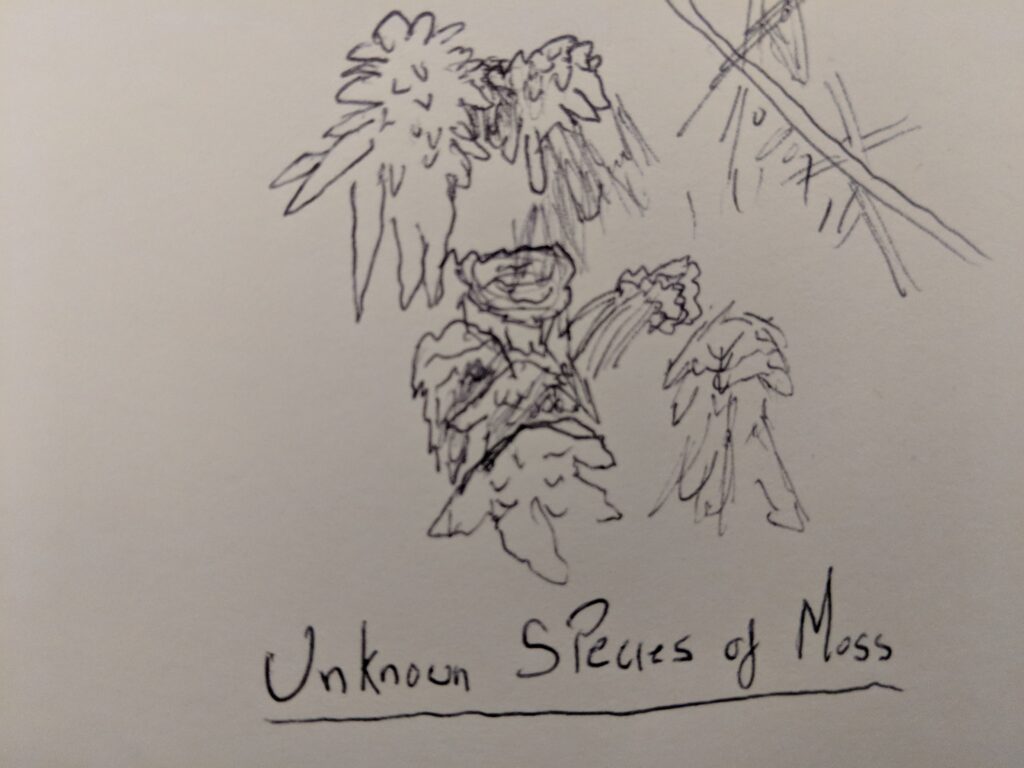
Beginning to bud is the Beech tree in this season, and from its buds come a small pedaled green flower. Throughout my site of phenology, Beech trees grow in groves sprouting from one anthers root structure, adding green to the deciduous canopy. Besides the occasional budding, there is very little flowering as of yet and the conifers stand bountiful among the forest, boasting a forever green selection of needles.
Spring Break Montreal Phenology
Posted: March 18th, 2019 by banders7
As someone entering the field of forestry, the most apparent tree species throughout my time in Quebec was the Maple. Vermont also is composed mainly of Maples, but mostly in the form of indigenous Red and Sugar species. In my Phenology spot of Quebec, it was compromised almost entirely of Silver and Norway Maple species, both of which are invasives sequestering local sugar maple species. This is a sad state of today, as the Red Maple is the regions tree icon, and is found on the Canadian flag due to the extensive natural history Canadians have with Maple Sugaring.
Although almost all birds fly south for the winter from Canadian regions, one bird I did encounter in my phenology spot of Montreal was the Gray Jay, or Perisoreus Canadensis. I was able to identify it because of it’s distinct call, but I wasn’t able to find sight of it. After some research on the topic of this species of bird, I found that they are indeed quite distinct in how they approach wintering in the dark cold of such a northern region. To do this, they store extra food supplies from the summer months in the ground, and with a developed sense of memory, they are able to find the piles again come winter, like a species of squirrel would do. This is an interestingly developed ability for a bird to have, as they posses one of the smallest sized brains of any mammal proportionally.
Although I was able to hear the call of one Gray Jay, unfortunately the forest floor was not as occupied with indigenous animals. This demonstrates the low suitability of the region of Quebec for most organisms during winter months. Not only this, but many mammal species around this area survive the cold weather by hibernating under the warm cover of their den. Even if not technically hibernating, local species like the Arctic Fox, or Vulpes lagopus, will limit movements to within a few miles of their den, and sleep through most of the long winter. This makes it especially hard to spot any nearby wildlife, despite enhanced tracking capabilities because of snow cover.
Wetland, Woodland, Wildland Winter Phenology
Posted: March 8th, 2019 by banders7
When asking which category this phenology site would fall into in the Wetland, Woodland, Wildland model, the answer would certainly be an Open Upland Community, which falls under the category of a Wildland. This is a site of Wildland because a portion of it falls on a cliff side, which not only distrubs local vegetation but also increases hydrological run-off. This run-off causes soils to shift toward sandier conditions and undergrowth is not allowed to fully take root because of fast moving waters.
This site is more specifically formed of the qualities of an Open Upland Community as it has Cliffs and Talus in one area of the site, but shifts towards outcrops and upland meadows in the other half. Both of these fall under the Open Upland Community category, meaning it is entirely a site of Wildland.
At the site, some of the traits I noticed which led me to this conclusion we’re in the state of the canopy structure. While inland portions had began to form outcrops of tree stands, there was no dense forest like what an undisturbed Northern hardwood would see only a few hundred feet inland. Additionally, the cliffside leading to lake Champlain is quite steep, and only the occasional small shrub is able to find livable conditions on that slope, meaning it is clearly labeled as an open Wildland.
This far into the winter season and with the Hydrological pressures of recent weather patterns, the cliffside saw a lot of erosion. Already pressured by hydrological intensity, this further pushed the cliff inward and potentially brought brush off the landscape and into the shore. One of the most notable changes to phenology since my last visit is the frozen state of the lake. Everyone has begun to bring their dogs and kids out to walk out on the lake and watch as amazing sunset framed by the Adirondacks. Furthermore, all traces of active bird life have disappeared, leaving behind only the low echo of the wind between trees branches and needles, as even the last stranglers looking to move south are long gone by now.
Tracks and Winter Phenology (2/5/19)
Posted: February 5th, 2019 by banders7
This phenology spot has seen a lot of change since my last visit! The snow has piled up, although the rain and high temperature conditions over these last few days must have reduced the snow coverage significantly, to a point where in some areas I can see patches of green grass poking out from the understory of white. With snow comes tracks! But here, unfortunately, is not a place of uncontacted nature. In fact, I believe that most of the wildlife activity is drawn further away into Red Rocks national park because of all the human activity this close to the Burlington Bike path. While there were many birds to witness in the fall season, there are not as many land mammals to leave tracks in the snow, and even the birds have migrated south for a warmer season. I don’t blame them, ourselves keeping close to 0 degrees on the average day here in Febuary.
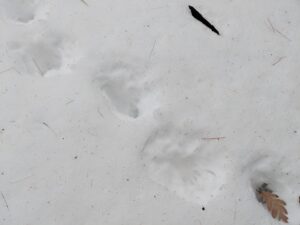
These are “tracks” I found in my phenology spot. From what I can make out, it looks like a human footprint followed by an accompanying dog, which I can makes out from the larger, round boot-shaped footprint, followed by a five pointed claw which sits in the middle.
The Deciduous tree species I was able to identify were: Red Oak, White Oak, Sugar Maple, Striped Maple, Basswood, and Black Cherry. The most prevalent of these were the Red Oak and Sugar Maple species, making me believe that at least some of this forest has avoided clearing for a good amount of time, and been able to pass its pioneer stage of birches and pines into a deciduous hardwood forest full of trees like the ones I listed above.
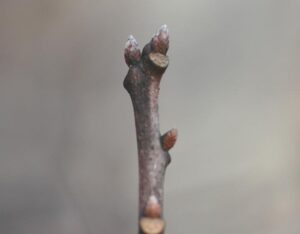
 ,
,
Here is a photo of one of the twigs from the red oak (left), along with a drawing of a different red oak twig. In my drawing, I give the twig a terminal and lateral bud, meaning that the twig ends with the terminal bud. In the photo though, there is no terminal bud, as instead the twig seperates at the end into multiple buds. Red oak can take on either of these features in its twigs.
Human History
Posted: December 8th, 2018 by banders7
In the mid-1800s, the logging industry in the North-East region of the U.S.A was booming, and so many areas close to the Burlington waterfront were cleared to produce train railways to help support the massive shipping industry which goes along to support all of the exponential logging. This logging leads to an increase in cleared, developed land, and contributes to the peak of 80% clearage we see in Vermont in the 1800s. As time passes, use of the railroads declined into nonexistence until state parks adjacent to my area were formed like Red Rocks and public spaces like the Burlington Bikepath were installed to help reproduce the beauty of the landscape around lake Champlain, and the public’s accessibility to that resource.
This allowed the reintroduction of native tree species back into the environment, forming the young white-pine stand we see today at my place of Phenology. Hopefully, as time passes, human impact on the space will continue to decline until native wildlife populations can begin to move back into relatively undisturbed areas near their primary water source of Lake Champlain. There is incredible natural beauty waiting to be set free in the ecosystem surrounding and encompassing Lake Champlain, and it should not be wasted as an area of human development, but instead let free as we are making steps towards to day to becoming a stunning wildlife preserve and public, natural space. From all of the city it provides an amazing view which should serve as a reminder of our priorities as moral bound beings to serve the beauty which we have a singular purpose of protecting in our own lives.
Today we can still see the remnant effect of human history on my place of phenology. The most notable of these landmarks is the old chimneys which litter the landscape, the final remains of old developments which have been long forgotten and devoured by natural regrowth. In addition though, the bikepath and sad amount of litter both present reminders that you are not deep within a natural preserve but instead on the perimeters of a high population city.
Middleton MA Phenology Spot
Posted: November 26th, 2018 by banders7
https://www.google.com/maps/d/edit?hl=en&mid=1KAeci__M0WaEFKFL6Mb40BS-1tqG91lF&ll=42.61416658183627%2C-71.00492639999999&z=18
Coordinates: 42.61416, -71.00492
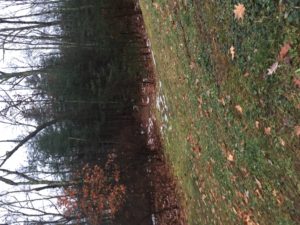
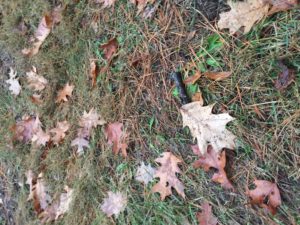
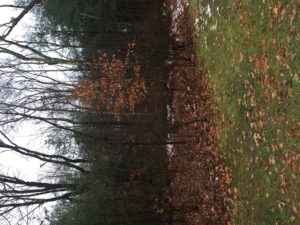
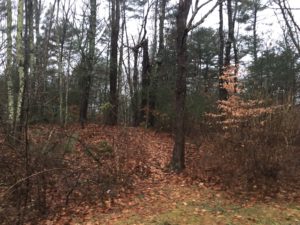
Here is a place of great cultural and natural significance, a yard whose perimeter has stayed constant for centuries. This traditional maintenance has allowed for the development of needed old-growth forest, and created a defined line of which hardwood oak forest surrounds grass pasture. The forest has marked age from its developed under story which is full of aged and dying humus and organic compound. The tree composition is almost entirely made up of Pine, Hemlock, White Oak, and Northern Red Oak. Because of this large quantity of Oak, the ground is littered in the fall colors of orange leaf matter which envelop some remnant of pine needles. There was clearly a recent storm, as some small saplings were able to make their way upwards towards the sky because of the death of their mother trees. Large trunks litter the ground, some sporting burn marks which could indicate a strike of lightning. While in the timespan of a human generation the forest looks stagnant, and of no overall consciousness, it grows further into the yard every decade, and perhaps the future owners of this land will allow this progression of pioneer trees such as paper birchs into the land, and the reforestation so common of this age in abandoned farming fields will take place once again.
The glaring difference between the place of phenology in Burlington VT and in Middleton MA is in the forest composition and surrounding grassy area, maintained by human force. In Vermont, the tree composition is mostly spruce and other connifers such as douglas firs. Here, it leans towards hard woods as mentioned previously. This is because the forest is in an area of reduced interaction with humans, which is separated from the area which is occupied by humans. In opposition to this, the spot from Vermont is part of a park system frequented by human travelers, not allowing for natural development. In addition, clearings and trail systems are put in place in the spot from Burlington, directly impacting the area, whereas here, the natural area is removed from any interference. Besides these major differences, there is also more under story composition in the form of bushes and decaying organic matter. In addition, there is active wildlife and birdcalls can be heard with much more frequency than in my burlington environment.
Event Map
Posted: November 5th, 2018 by banders7
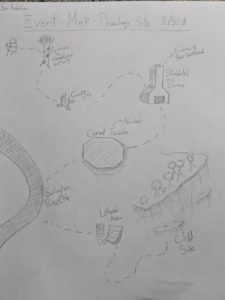
This week, the phenology of my site has shifted further into the reaches of winter. Leaves have fallen completely from their deciduous trees, and the weather has become crisp and harsher. Additionally, wildlife noises have come to silence, as birds have parted on their migration towards warmer temperatures in the south.
The birds have abandoned their homes
In search of more forgiving climate
But the trees must remain
Offering the hard work of summer and spring
Littered in many colors
Upon the hard ground
Pressed down by the boots of
Students of Nature
and Ignorant people
who have gone too far from home
alike.
Bird’s Eye View and Phenological Changes
Posted: October 22nd, 2018 by banders7

Since the first assignment at my Phenology site, there have been many noticeable changes on the environment. One of these is a renewed activation of what must be a woodpecker. One tree central to the site has been providing habitat and food source for a woodpecker, but it wasn’t until this last visit that I realized the woodpecker was still local and active. Here are photos of old (right) pecking sites and the new (left) one for reference:


One of the largest changes my site of Phenology has developed over this last month is in its foliage, as canopy leaves have begun to change color and fall into the under story. However, as most of the site is comprised of Coniferous, softwood trees, the foliage colors are minimal and most of the ground cover is comprised of pine needles instead of leaves.

Hello world!
Posted: October 8th, 2018 by banders7
Welcome to UVM Blogs. This is your first post. Edit or delete it, then start blogging!


Recent Comments